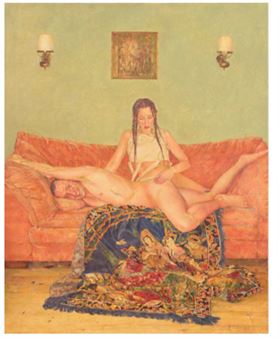The Floral Impulse
David Castillo presents The Floral Impulse, an exhibition of works by over 25 artists organized by Xaviera Simmons in curatorial collaboration with David Castillo. Simmons included artists who naturally intersect with her own practice in concept and/or aesthetics. In painting, sculpture, photography, assemblage, and video, the exhibition contemplates the long history of the floral still life genre and the mythologies, symbolisms, and historical references encoded within pictorial representations of flowers.
From humanity’s earliest recorded histories, the flower has served an intimate, sensual, and visceral role as a subject of allegorical meaning. Florals have long ornamented and bloomed across fundamental aspects of life as expressions of mourning, growth, remembrance, love, beauty, ritual, and resistance. In the inverse, flowers have at times been coded as shallow tokens of adornment or decay. Their uses and representations span time, place, and culture, in many ways forming a familiar and unifying grammar that connects human experience across its myriad conditions.
The floral measures time and marks history. The fleeting nature of life and its simple pleasures emerged among the moralizing themes imbued into flowers—as subject and symbol—during the late Renaissance, when the still life genre flourished in Northern Europe. Artists of the period depicted flowers in all their states, from bud to bloom to their inevitable wilting. These memento mori and vanitas paintings emphasized life’s transience, fragility, and frivolity in the grander scheme, reminding the viewer of their own impending mortality: They, like the flower, will one day wilt. Two centuries later in the Victorian era, interest soared in floriography, the symbolic language of flowers, allowing friends and lovers to communicate, through coded floral arrangements, the desires their society would not allow them to voice aloud. The Impressionists later took to flowers en plein air, capturing the beauty, immediacy, and ever-changing conditions of the natural world. And from Modernism to the contemporary, florals have been portrayed and iconized across a multitude of styles and movements that reinterpret their shapes, forms, colors, and significations.

Recommended for you
David Castillo presents The Floral Impulse, an exhibition of works by over 25 artists organized by Xaviera Simmons in curatorial collaboration with David Castillo. Simmons included artists who naturally intersect with her own practice in concept and/or aesthetics. In painting, sculpture, photography, assemblage, and video, the exhibition contemplates the long history of the floral still life genre and the mythologies, symbolisms, and historical references encoded within pictorial representations of flowers.
From humanity’s earliest recorded histories, the flower has served an intimate, sensual, and visceral role as a subject of allegorical meaning. Florals have long ornamented and bloomed across fundamental aspects of life as expressions of mourning, growth, remembrance, love, beauty, ritual, and resistance. In the inverse, flowers have at times been coded as shallow tokens of adornment or decay. Their uses and representations span time, place, and culture, in many ways forming a familiar and unifying grammar that connects human experience across its myriad conditions.
The floral measures time and marks history. The fleeting nature of life and its simple pleasures emerged among the moralizing themes imbued into flowers—as subject and symbol—during the late Renaissance, when the still life genre flourished in Northern Europe. Artists of the period depicted flowers in all their states, from bud to bloom to their inevitable wilting. These memento mori and vanitas paintings emphasized life’s transience, fragility, and frivolity in the grander scheme, reminding the viewer of their own impending mortality: They, like the flower, will one day wilt. Two centuries later in the Victorian era, interest soared in floriography, the symbolic language of flowers, allowing friends and lovers to communicate, through coded floral arrangements, the desires their society would not allow them to voice aloud. The Impressionists later took to flowers en plein air, capturing the beauty, immediacy, and ever-changing conditions of the natural world. And from Modernism to the contemporary, florals have been portrayed and iconized across a multitude of styles and movements that reinterpret their shapes, forms, colors, and significations.
Artists on show
- Adler Guerrier
- Alejandro Garcia Contreras
- Amber Cowan
- Austin Lee
- Cruz Ortiz
- Daniel Gibson
- Devan Shimoyama
- Grant Levy-Lucero
- Jillian Mayer
- Johannes Bosschaert
- Kalup Linzy
- Lyle Ashton Harris
- Maria de Los Angeles
- Matthew Day Jackson
- Nabeeha Mohamed
- Nadir Souirgi
- Naomi Fisher
- Pepe Mar
- Petra Cortright
- Rachael Anderson
- Rachel Rose
- Se Jong Cho
- Shinique Amie Smith
- Su Su
- Timo Fahler
- Xaviera Simmons
- Yesiyu Zhao
Related articles
Anticipating Art Basel's return to Miami Beach (1–3 December 2022), Ocula Magazine shares a critical selection of must-see exhibitions across the city's main galleries and institutions.
















